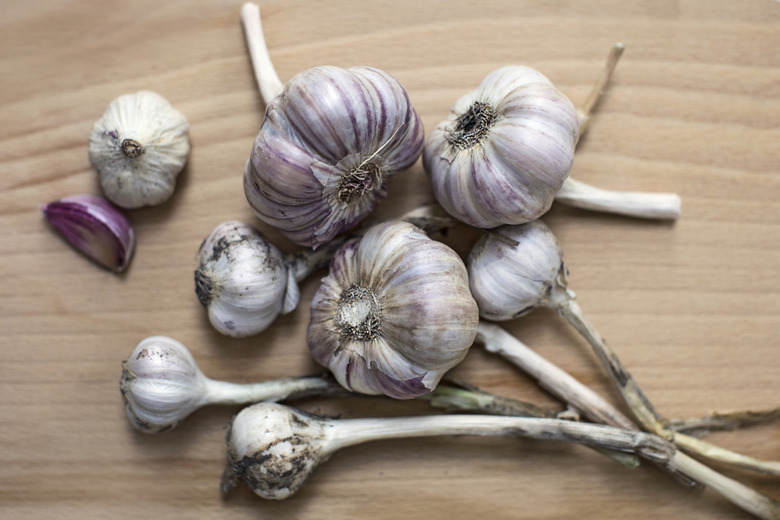How To Plant Garlic In Zone 6
Garlic (*Allium sativum*) is one of the oldest plants cultivated by humans. Affectionately known as "the stinking rose," this perennial vegetable, herb and functional food originated from a wild species indigenous to Asia and is now naturalized throughout Europe and adapted to U.S. Department of Agriculture plant hardiness zones 3 through 8. With relatively mild climatic conditions and a long growing season, USDA zone 6 works well for growing garlic.
Step 1
Three basic types of garlic exist: soft neck garlic (Allium sativum var. sativum), hard neck garlic (Allium sativum var. ophioscorodon) and giant garlic, also known as elephant garlic (Allium ampeloprasum). Although all three will grow in USDA zone 6, some perform better in certain regions within this zone. For example, soft neck varieties, such as 'California Early' (Allium sativum 'California Early') are best suited to the temperate climate of southern regions in zone 6, while hard neck types, such as 'Purple Italian' (Allium sativum 'Purple Italian') thrive in the cold winters and cool springs typical of states north of latitude 37 degrees. Elephant garlic, which is actually a type of leek (Allium ampeloprasum) and not a true garlic, is larger but less hardy and better adapted to the mid-Atlantic and southern regions within zone 6.
Step 2
Site Preparation
Step 1
Garlic needs a sunny location and organically rich, well-drained soil with a pH level between 6 and 7. Sandy or loam soil is preferred, but heavy clay soil is fine if amended with compost or manure at a rate of 100 pounds per 100 square feet. To fertilize, work a balanced 10-10-10 slow release granular fertilizer into the top 3 to 4 inches of soil at a rate of three pounds per 100 square feet.
Step 2
- Three basic types of garlic exist: soft neck garlic (*Allium sativum var.
- Elephant garlic, which is actually a type of leek (Allium ampeloprasum) and not a true garlic, is larger but less hardy and better adapted to the mid-Atlantic and southern regions within zone 6.
When to Plant
Step 1
Although garlic can be planted in late winter or early spring, fall planting yields bigger and more flavorful bulbs. Garlic should be planted after the first frost and four to six weeks before the ground freezes, generally mid-October for most locations within USDA zone 6. Garlic requires a cold period to sprout, however, so if you live in a southern region within zone 6 and temperatures remain above 40 degrees Fahrenheit, refrigerate bulbs for two or three weeks before planting.
Planting Garlic
Step 1
A few days before planting, break bulbs apart by hand but do not peel. Plant cloves pointed end up 4 inches deep and 5 to 6 inches apart. Top off with 3 to 4 inches of mulch consisting of leaf litter, compost or straw. Water the site to be sure the mulch stays in place.
Step 2
- Although garlic can be planted in late winter or early spring, fall planting yields bigger and more flavorful bulbs.
- Garlic should be planted after the first frost and four to six weeks before the ground freezes, generally mid-October for most locations within USDA zone 6.
- Garlic requires a cold period to sprout, however, so if you live in a southern region within zone 6 and temperatures remain above 40 degrees Fahrenheit, refrigerate bulbs for two or three weeks before planting.
Continued Care
Step 1
Remove mulch in spring after the danger of frost has passed, which is mid-May in zone 6. Hard neck garlic produces a flower stalk or scape, which should be cut back (or cooked) because they reduce bulb size. Keep plants evenly moist while they are producing bulbs and leaves by watering every three to five days in May and June, more often if conditions are very dry. Garlic grown in zone 6 is ready to harvest between June and July, indicated by browning of the lower half of leaves.
References
- Old Farmer's Almanac: Garlic
- Southern Exposure Seed Exchange: Garlic and Perennial Onion Growing Guide
- Southern Exposure Seed Exchange: Garlic
- Urban Farmer: Planting and Growing Garlic
- University of Georgia: Garlic Production for the Gardener
- Green Mountain Garlic: The Growing Process
- Burpee: Growing Zone Information
